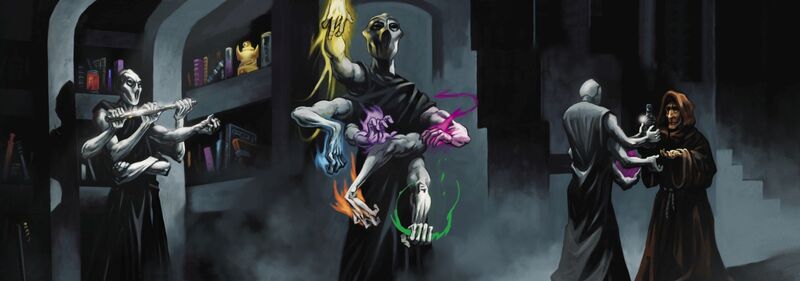Spellweavers, also known as Weavers, were a race of highly intelligent humanoids originating from an alternate Prime Material plane.[4]
Gifted with an unprecedented mastery of the Art, they built an empire that spanned the multiverse before meeting a tragic and almost instant end.[2]
Description[]
Weavers were alien-looking creatures: their frail bodies sported six arms, and an exceptionally long neck around which they could easily turn their head completely.[2] Their skin was smooth and hairless and was usually gray, with patches of beige, pink or yellow.[2] They sported a genderless, vaguely bird-like figure; and a pair of large, dark eyes.[3] Their blood was metallic blue in color, reminiscent of quicksilver.[2] The skin of young spellweavers was a dark shade of gray, and would lighten up as they got older.[2]
Abilities[]
The body and mind of spellweavers were incredibly in tune with arcane magic. As a result they displayed an incredible mastery of the Art, using powerful telepathy, invisibility, and accomplishing feats such as casting up to six spells at once.[1][3] Their senses highly attuned to magic allowed them to detect magic and invisibility 100 ft (30 m) around them.[4]
Their natural dominion over magic was akin to that of sorcerers,[2] and they could disregard the use of verbal and material components when casting spells.[4]
Due to their alien minds, spellweavers were immune to mind-affecting spells and to scrying effects targeting their mind.[3] Although immunized to fear, weavers would still retreat if they felt it was the logical choice to make.[4] Any creature attempting to communicate with a spellweaver telepathically would suffer terrible backlashes.[3][4]
The telepathic powers of spellweavers extended to a limited version of psychometry, allowing them to read the "memories" of certain magical objects—especially specific magical gems.[2]
Some spellweavers were able to create a temporary region of planar impenetrability around themselves once per day, preventing scrying and teleporation in a 200 ft (61 m) radius.[4]
Chromatic disks[]
Every spellweaver owned a chromatic disk which they kept with them at all times. More than simple objects, the disks were extensions of the weavers themselves, and were created by exuding blood and fluids during meditation, coalescing them in the form of a 6 in (0.15 m) diameter disk made of metallic resin harder than steel.[2] These disks were nigh-indestructible, but would explode should anyone beside a weaver try to use them.[3][4]
Chromatic disks were so named because they glowed with a bright light that slowly shifted through the spectrum of visible colors.[3][4] Spellweavers could somehow control this color shift, which they used to communicate to each others alongside telepathy.[2]
Chromatic disks were magical batteries, not unlike a pearl of power but many times more powerful.[3][4] They could also be used to trap the soul of their foes, an ability usually used on powerful spellcasters.[2]
Lifecycle[]
Although spellweavers might have appeared immortal to other races,[1] their lifespan was only six centuries.[2] Age didn't affect a weaver's physical abilities, and the race had no children: they were born as full-functioning adults through a peculiar ritual.[2]
At some point during their long life, spellweavers would instinctively sense that their life would be ending soon.[2] When this happened, an elder weaver would create a magical "coffin" through a ritualistic hibernation trance which consumed a near-priceless amount of magic items.[2] The trance usually lasted for about one month, but had been known to sometimes last for centuries instead—a time during nothing could wake them up.[2] Upon waking up, the weaver would be physically restored and rejuvenated, their skin darkening and their lifespan increasing by another six centuries.[2]
Reproduction[]
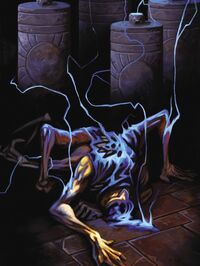
A spellweaver sacrificing itself during the breeding ritual.
Spellweavers didn't reproduce by any traditional means. As their restorative trance only functioned six times, an elder who already regenerated that many times would perform a final ritual of self-sacrifice which gave birth to six new adult weavers sharing the ancestor's memories and mental abilities.[2]
This special ritual required breeding vessels only found in very rare spellweaver bases, and caused the body of the parent to decay and disappear into nothingness.[2]
Obviously, both the regenerative ritual and the reproductive ritual were closely guarded secrets, and never revealed to other races.[2]
Personality[]
Claiming their civilization was older than the birth of the deities, the Weavers believed themselves to be above the gods and didn't care for divine magic.[1]
Spellweavers continuously looked for magic items, necessary to power their furnaces and to accomplish important rituals.[2] While they were open to trading,[2] they weren't opposed to using force or persuasion to accomplish their goals.[1]
Activities[]
The Spellweavers were responsible for creating the first of the black obelisks―powerful, reality-shaping devices that could be used to manipulate time itself. All knowledge regarding the black obelisks and their creation were stolen by powerful, Oerthian mage Vecna.[6]
Combat[]
Spellweavers often initiated combat themselves, organizing thoroughly planned raids against targets of high magical power.[1] Raids could be prepared months in advance, using scrying magic and spies to get information on their target.[1] They usually involved teleporting the weaver and its allies in the enemy base, using invisibility to move close to their target, tying any guards, and teleporting back as soon as the deed was done.[1][4] Targets of such raids were either magic items, or powerful spellcasters whose soul they siphoned with their chromatic disk.[1]
Society[]
While all spellweavers were masters of magic, some were classified by sages in multiple categories depending of their specialties:
- Battle Weavers were masters of melee combat, using their six arms to wield multiple blades in a deadly ballet. They hunted down the best combatants in existence, aiming to capture worthy souls in their disk.[1]
- Thought Weavers were masters of the mind, dominating their enemies with psychic powers. They were usually the masterminds behind successful raids and complex schemes.[1]
- Hex Weavers drew power from the Shadowfell itself. They usually followed their own plans, puzzling even other weavers and sometimes pitting them against each other.[1]
After the Disjunction, it was rare for multiple spellweavers to work together. When this happened, it was usually to form a raiding party aiming to seize a particular magic item.[3]
Goals[]
Spellweavers spent most of their time trying to rebuild their ancient civilization.[1] In order to do this they sought out the ruins of their former colonies—called "nodes"—which often took the form of huge pyramids of stone and steel. Once found, the weavers repaired and reactivated them.[1] Weavers usually built a single node per continent, world, or plane of existence—making their discovery a true rarity.[2]
Reactivated nodes were linked together through a network of planar portals and housing huge furnaces capable of draining the souls of mortals and the power of magic items.[1] After the fall of their empire no furnace could be found that wasn't destroyed, but weavers kept looking for them, as a live node furnace had a power that could rival that of the deities themselves.[2]
In addition to items powering their furnaces and rituals, the weavers looked for rare magical gems containing pieces of "memories" of a specific magical formula called the "Code of Reversion", created before the fall of their empire.[2] Any weaver who found and memorized all parts of the Code would be able to cast the corresponding spell, which effect would be to revert the entire multiverse to the point in time when the Code was created—before the fall of their empire.[2]
Lairs[]
After the Disjunction, some weavers built lairs in all sorts of places.[4] These lairs contained between one and eight 10 ft (3 m) tall pillars of stone or wood covered in indecipherable magical runes.[4] The goal of the lairs was unknown, and seldom studied as doing so could provoke side effects ranging from mild headaches to severe mental damage.[4]
Religion[]
Spellweavers didn't worship any deity—they were strict atheists, and actively shunned any religious practice.[2] They believed themselves above the gods, denying their divinity and mysteriously hinted at some undermining secret behind their powers.[2]
The closest thing to religious rituals weavers had was a pious reverence towards their ancestors.[2] They would often meditate to reminisce about the golden age of their empire and to better understand the will of the previous generations.[2]
In addition, numbers were sacred to spellweavers—especially the number six. They had six lives, could regenerate six times, and their numbering system revolved around the number six instead of ten.[2]
Language[]
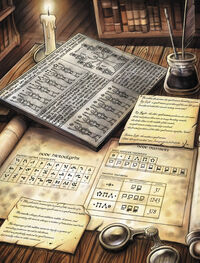
A study of the Breeding Tablet, one of the most infamous spellweaver documents ever discovered.
Spellweavers had an incredibly complex language made of clicks and whistles.[2] However, they never used it, and only knew of it from distant memories, as an ancient law forbade their kin from speaking in an effort to develop their telepathic abilities.[2] Even when hurt, they would never emit words—only high-pitched squeals or grunting.[2]
The only remaining traces of the original spellweaver language was its written form, passed through generations as node hieroglyphs.[2]
When communicating together, weavers used three different channels:[2]
- their telepathy, which could reach up to 1,000 mi (1,600 km) away[3]
- their chromatic disks, whose colors they could shift[2]
- a complex sign language using their six arms and their long neck[2]
These three means of communication weren't redundant, and when used simultaneously weavers could communicate hours of explanations and dialog in mere minutes.[2] Spellweaver communication was so complex that it was totally incomprehensible to other races.[2]
For reasons unknown, weavers would sometimes leave written notes where other humanoids could find them.[3] These messages were always incoherent rambling, and only raised more questions amongst the sages studying them.[3][4]
Empire[]
At the peak of its power, the spellweaver empire was mostly peaceful.[2] Highly intellectually advanced, they kept the role of watcher over the multiverse, only occasionally subjugating more primitive creatures to perform chores and hard labor.[2] Above all, spellweavers liked to study semantics, and traveled the multiverse to study other cultures, their symbols, languages and codes. Through those studies they developed uncanny telepathic abilities and incredible magical talents.[2]
When encountering a race that posed a threat to them, the weavers gifted them with powerful magical items and artifacts, and let them implode from within.[2] After the fall of the empire, some weavers continued to keep this tradition alive.[2]
Uses[]
Spellweaver remains had magical properties. Notably, a spellweaver skull was amongst the ingredients of an antidote against the zombie plague which hit Chult in the late 15th century DR.[7]
Relationships[]
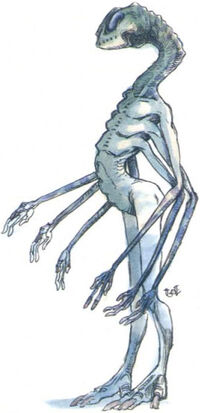
Spell weavers had strangely alien bodies.
Nerra[]
Weavers had a strong relationship with nerra, humanoids with mirror-like skin who helped build the portals connecting their bases.[1] Some sages believed that the nerra were an artificial race created by the Weavers.[1]
Other races[]
Spellweavers were not against using other races as servants,[1] or allying themselves with powerful factions if it served their plans.[8] They favored working with races opposed to the gods, and with elemental forces such as efreet.[1]
If they needed to negotiate with other races, the Weavers would often call a meeting in the City of Brass.[1]
History[]
According to spellweavers—mostly from their written history—their civilization was a great empire that spanned the multiverse and predated the creation of the gods and primordials, in times long forgotten.[2][1]
The empire stood against a terrible enemy from the Far Realm, trying to prevent a seed of chaos from entering the cosmos. They partly failed and the seed ruptured, destroying their homeland and scattering it across the planes.[1] According to them, this event created the Astral Sea and the Elemental Chaos.[1]
Weavers referred to this catastrophe as "the Disjunction", to the golden age preceding it as "the Time of Nodes", and to the following ages as "the Scrabbling".[2]
According to sages studying them, it was unclear if the history told by the spellweavers was true. Some speculated that they had tried to acquire total knowledge of all existing communication across reality, while others believed the fall of the empire was due to a grandiose but failed attempt to alter reality itself across the multiverse.[2] According to those sages, every furnace exploded one after the other in a chain reaction that destroyed the empire in a single moment. Only a few weavers were away from the nodes at the time, and became the ancestors of all subsequent members of the race.[2]
In the Year of the Maelstrom, 1101 DR, the city of Treshla was destroyed by a pod of beholders seeking to eradicate a spellweaver base located in the city's catacombs. As a consequence, the spellweavers went further underground, and settled north on the fallen kingdom of Barakuir.[9] According to rumors, some spellweavers still lurked in tunnels far below Treshla.[10]
During the Year of Lightning Storms, 1374 DR, gold dwarves from the Great Rift allied themselves with a colony of spellweavers to help fight duergar and their beholder allies in the war for the reclamation of Shanatar.[8]
Legacy[]
The legacy of the spellweavers endured on the world of Toril. Their secrets of their black obelisks were reclaimed by the Netherese arcanists, who created new, less-powerful versions of the devices for their flying cities. As the empire fell, the obelsisk aboard their enclaves became scattered across the face of Faerûn.[6]
Rumors & Legends[]
The Forgotten One[]
Both the spellweaver and thri-kreen races were rumored to have a connection to the divine self of Jergal, the "Lord of the End of Everything".[11]
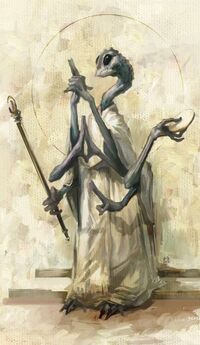
Cause of the Disjunction[]
While none knew the exact cause of the Disjunction—not even the weavers themselves—two theories were prevalent amongst sages:
- Some believed that the spellweavers discovered the prime form of communication, words capable of shaping reality itself, and tried to ascend a whole part of their civilization to godhood at the same time. Proponents of this theory believe that the gods, in order to prevent this, caused a magical backlash that destroyed all nodes.[2]
- Others believed that the spellweavers discovered that at the beginning of things, all planes and worlds were united in a single, balanced reality—before being broken by the whims of the gods. Proponents of this theory thought that the weavers tried to return reality in this balanced state, by building nodes as "anchors" of sorts to bring the planes back together. But the power of "infinite infinities" being merged back together was too great, and the procedure failed with terrible consequences.[2]
- One story told that the lich-god Vecna used the secrets of the spellweavers' black obelisks to erase all records of the spellweavers from existence, past and present.[6] It was not entirely clear if this event was related to the Disjunction.[speculation] This possible explanation appeared to be contradicted by the rumors and confirmed presence of spellweavers on Toril as of the 12th and 14th centuries DR.[10]
Goals[]
The end goal of the spellweaver race after the fall of their empire was unknown to all but them. However, some sages believed that they still tried to reunite the planes together—an event of apocalyptic proportions that would kill all, including the gods themselves.[1]
Appendix[]
| This article is incomplete. This article needs more information from Phandelver and Below: The Shattered Obelisk. You can help the Forgotten Realms Wiki by providing more information. |
Appearances[]
Adventures
Icewind Dale: Rime of the Frostmaiden
References[]
- ↑ 1.00 1.01 1.02 1.03 1.04 1.05 1.06 1.07 1.08 1.09 1.10 1.11 1.12 1.13 1.14 1.15 1.16 1.17 1.18 1.19 1.20 1.21 1.22 1.23 1.24 1.25 Mike Mearls, Greg Bilsland, Robert J. Schwalb (June 2010). Monster Manual 3 4th edition. Edited by Greg Bilsland, et al. (Wizards of the Coast), pp. 202–205. ISBN 978-0-7869-5490-2.
- ↑ 2.00 2.01 2.02 2.03 2.04 2.05 2.06 2.07 2.08 2.09 2.10 2.11 2.12 2.13 2.14 2.15 2.16 2.17 2.18 2.19 2.20 2.21 2.22 2.23 2.24 2.25 2.26 2.27 2.28 2.29 2.30 2.31 2.32 2.33 2.34 2.35 2.36 2.37 2.38 2.39 2.40 2.41 2.42 2.43 2.44 2.45 2.46 2.47 2.48 2.49 2.50 2.51 2.52 2.53 2.54 2.55 Tito Leati (December 2005). “Ecology of the Spell Weaver”. In Erik Mona ed. Dragon #338 (Paizo Publishing, LLC), pp. 62–68.
- ↑ 3.00 3.01 3.02 3.03 3.04 3.05 3.06 3.07 3.08 3.09 3.10 3.11 3.12 Ed Bonny, Jeff Grubb, Rich Redman, Skip Williams, and Steve Winter (September 2002). Monster Manual II 3rd edition. (TSR, Inc), pp. 187–188. ISBN 07-8692-873-5.
- ↑ 4.00 4.01 4.02 4.03 4.04 4.05 4.06 4.07 4.08 4.09 4.10 4.11 4.12 4.13 4.14 4.15 Ed O'Connell (November 1990). “The Dragon's Bestiary: A weaver of spells and disaster”. In Roger E. Moore ed. Dragon #163 (TSR, Inc.), pp. 82–83.
- ↑ David Wise ed. (December 1994). Monstrous Compendium Annual Volume One. (TSR, Inc), p. 103. ISBN 156076838X.
- ↑ 6.0 6.1 6.2 Christopher Perkins (September 2020). Icewind Dale: Rime of the Frostmaiden. Edited by Kim Mohan. (Wizards of the Coast), p. 255. ISBN 978-0786966981.
- ↑ Will Doyle (2016). Drums of the Dead (Book 2) (DDEP07-02) (PDF). D&D Adventurers League: Tomb of Annihilation (Wizards of the Coast), pp. 4, 18.
- ↑ 8.0 8.1 Ed Greenwood, Eric L. Boyd (March 2006). Power of Faerûn. (Wizards of the Coast), p. 28. ISBN 0-7869-3910-9.
- ↑ Eric L. Boyd (November 1999). Drizzt Do'Urden's Guide to the Underdark. Edited by Jeff Quick. (TSR, Inc.), p. 106. ISBN 0-7869-1509-9.
- ↑ 10.0 10.1 Steven E. Schend, Dale Donovan (September 1998). Empires of the Shining Sea. Edited by Julia Martin. (TSR, Inc.), p. 159. ISBN 0-7869-1237-5.
- ↑ Ed Greenwood, The Hooded One (2010-05-16). Questions for Ed Greenwood (2010). Candlekeep Forum. Retrieved on 2022-07-31.

